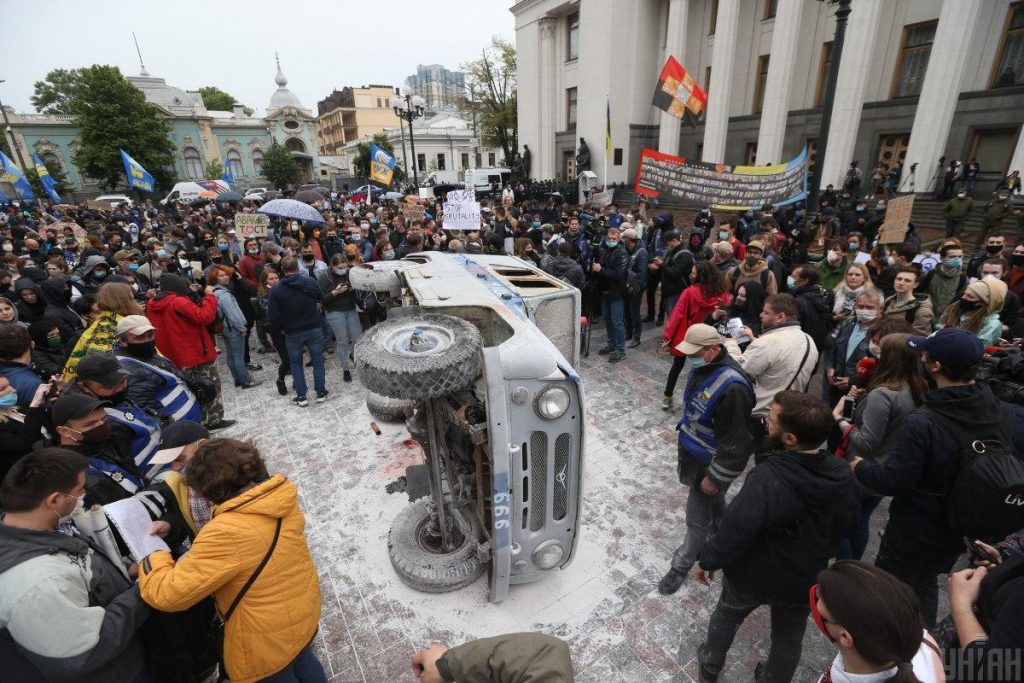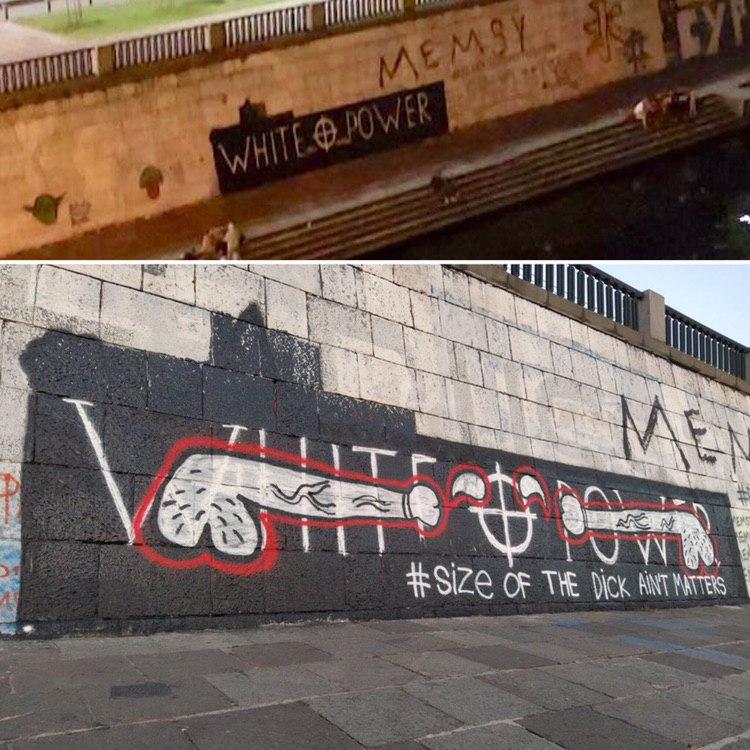The ongoing US riots against police violence have triggered solidarity gestures worldwide: besides organising their own protests against racist violence, activists in many cities reacted by creating thematic graffitis. In the early hours of June 4th, Ukrainian capital got one, as well: the painting, which was posted on the social media accounts of people from the milieu of the neo-Nazi Azov movement and the Dynamo football hooligans, features a poorly drawn person in the KKK hood performing the Nazi salute. He is standing next to the phrase “Can repeat” (sic) and a hashtag, #whitelivesmatter.

Instead of brushing this off as a yet another case of eastern savagery, it is worth unpacking the message and putting it in a context.
Peripheral and ironic
The first thing to note is the obviously peripheral character of the painting: it reacts to the events happening in the global core, and this reaction itself is, in turn, formulated in the language of that core. Like broken Latin in the Middle Ages, broken English today is the language of non-mundane writing in the global periphery: the language of tattoos, printed t-shirts, and graffitis. It’s not that the authors were addressing their message primarily to the Anglophone public; even if they might have had the background motive of sharing it with foreign comrades, the main audience were still Ukrainians. It’s just that English is the suitable language to communicate “important” messages, even between people who don’t use it in everyday interactions. Even decidedly “anti-globalist” far right ideas are shaped in a pretty uniform “globalist” manner.
Further, the graffiti recycles a slogan from contemporary Russian war propaganda. The phrase “We can do it again” (mozhem povtorit) refers to the Soviet victory over the Nazi Germany, but in Russian nationalist narrative it signifies military superiority of a primordial Russia over the West in general. In a similar vein of using elements of anti-fascist discourse to build militarist nationalist ideology, the state in Russia exploits the cult of heroic “grandfathers who fought in the war”. While there are plenty of people in the post-Soviet space who make simple and direct use of this public transcript to justify their nationalist or even far right views, many Russian and Ukrainian Nazis playfully reappropriate this narrative: the refrain of a song popular in this milieu says “My grandfather was an SS Sturmführer”. The graffiti is another case of such subversion: the attire of the militant ancestor indicates that he “can repeat” a different heroic feat.
This irony, typical for far right political subcultures, is usually lost on the politicised “normie” public in Ukraine, keen on two things: the “hybrid war” against Russia and denying the very existence of fascists in Ukraine, who are allegedly totally invented by Putin. Overcompensating for their tone-deafness, national-liberal intelligentsia tends to uncritically accept the most absurd rationalisations of far-right symbolism as a special humour of the patriotic youth. Thus, when photos of a Ukrainian veteran were removed from an exhibition in the European parliament because of visible swastika tattoos, he gave an interview wearing a Waffen-SS hoodie and said that “all [his] tattoos and posts in the social networks are outright trolling of the [separatist] fighters who regularly call us fascists”. This graffiti also has the potential of being explained away in a similar manner; one of the Instagram users who has posted it, has already commented that “it is a prank”.
The uncertain arm gesture depicted on the wall is very typical for the local Nazi scene, whose public figures are constantly forced to invent absurd justifications for the Nazi salute performed by them and their comrades; one typical strategy (besides claiming to “troll” or reminding of ancient Slavic roots of this gesture) is to claim that the camera caught them from a bad angle while they were showing something above or waving their hand. Posing for photos with a shy “lesser Nazi salute” (malaya ziga) or a vague gesture intentionally open to interpretations is a common practice, and we see the same strategy here: despite the unambiguous attire of the character, he is still depicted as if he’s not sure whether he wants to hail Hitler or to wave at friends. (Another possible explanation for the weird position of the arm in the picture is the generally acknowledged desperate scarcity of artistic skills in the muralist community of Kyiv.)
Despite the adorable shyness imposed by the constraints of local mainstream narratives, Ukrainian Nazis can simultaneously outdo their American counterparts in other radical gestures. The KKK suit, for example, raises fewer eyebrows in Ukraine, whereas in the US many “simple conservatives who even have Black friends” would feel the need to distance from this symbol, playing around with the arcane imagery of Pepe instead. Moreover, Ukrainian Nazis feel free to go ahead with the simple and bold slogan “white lives matter”, while not all far right in the US can afford such clarity. Instead, many are forced to discursively accentuate “all lives” or “blue lives”, or to fiddle with the vague promise that “the South will rise again”.
Polite riots
Appeals for respect for the police, omnipresent in the Trumpist camp in the US, are one thing which is largely absent from Ukrainian narratives condemning the protests. In the Ukrainian far right subculture, police hatred is very pronounced, which often surprises Westerners; “ACAB” tags in Kyiv are statistically as likely to be drawn by the Nazis as by the left. This general attitude did not change significantly even after 2014, when the most organised part of the far right movement, the Azov regiment, was integrated into the structures of the ministry of interior, headed by Azov’s longtime patron Arsen Avakov.

A recent case of outrageous police violence, in which officers of a provincial department beat up and repeatedly raped a woman, has triggered protests against Avakov. Azov reacted with a statement fully acknowledging the inefficiency and corruption of the police but warning against participating in the “global leftist campaign” aimed at “destabilising the situation”. Other far right groups took an active part in the protest on June 5, co-organising it with Holos, a national-liberal parliamentary party. The culminating point of the protest was when the protesters brought an old police car, used in the 1990s, and thoroughly trashed it. Reportedly, Holos had bought the car for the performance, paying $500 to the police officers for it. Nothing can be more distant from the spontaneous violence against the police property in the US.
Massive and not staged destruction of police vehicles was practised in the final days of the Euromaidan uprising of 2014, which has become the gold standard in Ukraine for evaluating all global politics. Conflicts in distant countries are judged based on the criteria of hypothetical proximity of the protagonists to Russia and of the struggle’s similarity to the Euromaidan. Ukrainian nationalists constantly shame Russian liberals for their failure to replicate Euromaidan in Russia and oust Putin – hence, Euromaidan is praised for its outstanding radicalism. However, when discussing current US riots or other protests in the West (e.g. the yellow vests movement in France), the dominating rhetoric is that of supposed orderly and “civilised” nature of Ukrainian uprising. The minority of Ukrainian intelligentsia which supports the US riots in principle does so with reservations about their violent character.
Just like in the US public sphere, conspiracy theorising is a sine qua non for Ukrainian discussions of the current protests. In both countries, there are two main versions as to the culprits behind the riots: they are either inspired by Vladimir Putin or by George Soros. The latter theory, upheld by the Trumpists in the US, is shared by the wide spectrum of the post-Soviet right: they appreciated the scheme in which the antifa are simultaneously dangerous terrorists and simple pawns in the hands of the Jewish billionaire. However, the bulk of the “fine society” in Ukraine – national liberals likely to acknowledge the legitimacy of the US anti-police violence protests in principle – accept the version promoted by the establishment of the US Democratic party, according to which the riots are the fruit of Russian president’s labour of sowing discord in the American society. Anti-Russian (and so automatically pro-Ukrainian) credentials in fact weigh more here than the amount of violence which is presented as the decisive factor. The recent statement in favour of the protesters by general James Mattis, hawkish secretary of defence who quit in protest against the troops withdrawal from Syria, has been more important for the “enlightened” far right and liberals in Ukraine than all the explanations about structural violence of American society.
Contingent whiteness
The paradoxes of uneven and combined global production of nazi discourse do not stop here. The authors of the graffiti sincerely consider themselves “white” – which is correct in the local Ukrainian racial landscape that counterposes, in terms of social hierarchy, Slavic/Jewish population to racialised Roma and “immigrants”. However, in all likelihood even the authors of the graffiti have relatives or friends working abroad, in the Western European countries, whose context relegates them to a racialised status below that of the “local” population.
Having reached its historical peak of 52.2 million in 1993, Ukrainian population has by now shrunk to 42.2 million (according to unrealistically optimist estimations of the statistical office, since the last census took place in 2001). In the words of geographer Vlad Mykhnenko, “In terms of natural population change, during the past two decades Ukraine has been amongst the fastest shrinking countries on earth, well ahead of Bulgaria, Latvia, Russia and Hungary, the world’s leaders in natural population decline”. Since 2014, this process has been greatly exacerbated by massive emigration: in 2014-2016, 25% of economically active population have left to work abroad. 75% of Ukrainian migrants work in the EU, where they have been the largest group to receive first-time residence permits in 2018. In Poland, which is the main destination for Ukrainian workers, the right-wing government welcomes them as a more acceptable alternative to the feared “Muslim refugees” – however, even in this situation of certified whiteness there are plenty of cases of racist attitudes towards Ukrainian guest workers in Poland. In other countries, “white” credentials of Ukrainians are more shaky – from Czechia, whose politicians allow themselves to complain about “dirty Ukrainians in trams”, to France, whose president recently lamented the existence of “Ukrainian and Bulgarian clandestine networks”, to Portugal, whose far right portray Ukrainians as one of the main threats to the racial purity of the nation.

Despite the sometimes deceptive looks, Ukrainians would hardly be considered “Whites” in countries whose politics is interesting enough for them to discuss. They occupy their place in the middle of the global pecking order, creatively experimenting with various techniques to climb higher: some simply identify with the most powerful group – US white business owners; others affirm their superiority on the “civilisational” basis, distinguishing themselves from the “Asiatic” Russians or “degenerating” Westerners; yet another strategy is to judge the “racist Ukrainians” from the position of enlightened intellectuals as opposed to the orientalised native masses. The one position which is extremely rare to find is a solidarity based on the shared class position – it does not imply any advancement of one’s social status.
***

A couple of days after the graffiti appeared, it was hastily “corrected” by political opponents, who have written “Pigs’ bitches” in Ukrainian over the painting (referring to Azov’s ties to the police). On the following morning, all of it disappeared under a layer of black paint with the classic and austere slogan, “White Power”, written above. Another night passed, and the slogan became adorned with two artsy (white) penises symbolically defiling the Celtic cross; the hashtag below said “size of the dick ain’t matters”. This is surely not the last transformation of this segment of the long Dnieper quay, but it is somewhat reassuring that political obscenities meet resistance in this nightly conversation of Eastern European urban youth.

Denys Gorbach is a doctoral researcher at Sciences Po Paris. His thesis deals with power configurations and moral economy regimes in an industrial city in the Eastern Ukraine. He is also interested in studying Ukrainian far right. Former leftist activist, he is currently a member of the editorial board of Spilne – Journal of Social Criticism.

